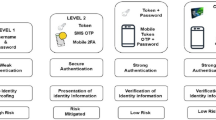Abstract
A novel protocol is proposed to address the problem of user authentication to smartcards using biometric authentication instead of the usual PIN. The protocol emulates expensive Match On Card (MOC) smartcards, which can compute a biometric match onboard, by using cheap Template on Card (TOC) smartcards, which only store a biometric template. The biometric match is performed by a module running on the user’s workstation, authenticated by a mobile agent coming from a reliable server. The protocol uses today’s cryptographic tokens without requiring any HW/SW modifications.
Preview
Unable to display preview. Download preview PDF.
Similar content being viewed by others
References
Bechelli, L., Bistarelli, S., Martinelli, F., Petrocchi, M., Vaccarelli, A.: Integrating biometric techniques with electronic signature for remote authentication. ERCIM News (49) (2002)
Bechelli, L., Bistarelli, S., Vaccarelli, A.: Biometrics authentication with smartcard. Technical Report 08-2002, CNR, IIT, Pisa (2002)
Bella, G., Bistarelli, S., Martinelli, F.: Biometrics to Enhance Smartcard Security (Simulating MOC using TOC). In: Proc. 11th International Workshop on Security Protocols, Cambridge, England, April 2-4 (2003)
BioAPI Consortium. BioAPI Specification Version 1.1, http://www.bioapi.org
Authenticode, http://msdn.microsoft.com/workshop/security/authcode/signing.asp
Roth, V., Jalali, M.: Concepts and Architecture of a Security-centric Mobile Agent Server. In: IEEE Proceedings of 5th International Symposium on Autonomous Decentralized Systems (ISADS 2001), Dallas, Texas, March 2001, pp. 435–442 (2001)
RSA Laboratories. PKCS#11-cryptographic token interface standard.
Bierman, E., Cloete, E.: Classification of Malicious Host Threats in Mobile Agent Computing. In: Proceedings of SAICSIT 2002, pp. 141–148 (2002)
Java Native Interface, http://java.sun.com/docs/books/jni/index.html
How To Share Data Between Different Mappings of a DLL. Microsoft KB 125677
Waldmann, U., Scheuermann, D., Eckert, C.: Protected transmission of biometric user authentication data for oncard-matching. In: Handschuh, H., Hasan, M.A. (eds.) SAC 2004. LNCS, vol. 3357, pp. 425–430. Springer, Heidelberg (2004)
Biometrika srl, http://www.biometrika.it
Schlumberger, http://www.axalto.com
Author information
Authors and Affiliations
Editor information
Editors and Affiliations
Rights and permissions
Copyright information
© 2005 Springer-Verlag Berlin Heidelberg
About this paper
Cite this paper
Bistarelli, S., Frassi, S., Vaccarelli, A. (2005). MOC via TOC Using a Mobile Agent Framework. In: Kanade, T., Jain, A., Ratha, N.K. (eds) Audio- and Video-Based Biometric Person Authentication. AVBPA 2005. Lecture Notes in Computer Science, vol 3546. Springer, Berlin, Heidelberg. https://doi.org/10.1007/11527923_48
Download citation
DOI: https://doi.org/10.1007/11527923_48
Publisher Name: Springer, Berlin, Heidelberg
Print ISBN: 978-3-540-27887-0
Online ISBN: 978-3-540-31638-1
eBook Packages: Computer ScienceComputer Science (R0)




